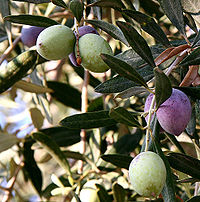
Photo from wikipedia
Fermented foods, in particular, surface-ripened cheese, represent a model to explain the metabolic interactions which regulate microbial succession in complex environments. This study explains the role of individual species in… Click to show full abstract
Fermented foods, in particular, surface-ripened cheese, represent a model to explain the metabolic interactions which regulate microbial succession in complex environments. This study explains the role of individual species in a heterogeneous microbial environment, i.e., the exterior of surface-ripened cheese. Through whole-metagenome shotgun sequencing, it was possible to investigate the metabolic potential of the resident microorganisms and show how variations in the microbial populations influence important aspects of cheese ripening, especially flavor development. Overall, in addition to providing fundamental insights, this research has considerable industrial relevance relating to the production of fermented food with specific qualities. ABSTRACT In this study, a young Cheddar curd was used to produce two types of surface-ripened cheese, using two commercial smear-culture mixes of yeasts and bacteria. Whole-metagenome shotgun sequencing was used to screen the microbial population within the smear-culture mixes and on the cheese surface, with comparisons of microorganisms at both the species and the strain level. The use of two smear mixes resulted in the development of distinct microbiotas on the surfaces of the two test cheeses. In one case, most of the species inoculated on the cheese established themselves successfully on the surface during ripening, while in the other, some of the species inoculated were not detected during ripening and the most dominant bacterial species, Glutamicibacter arilaitensis, was not a constituent of the culture mix. Generally, yeast species, such as Debaryomyces hansenii and Geotrichum candidum, were dominant during the first stage of ripening but were overtaken by bacterial species, such as Brevibacterium linens and G. arilaitensis, in the later stages. Using correlation analysis, it was possible to associate individual microorganisms with volatile compounds detected by gas chromatography-mass spectrometry in the cheese surface. Specifically, D. hansenii correlated with the production of alcohols and carboxylic acids, G. arilaitensis with alcohols, carboxylic acids and ketones, and B. linens and G. candidum with sulfur compounds. In addition, metagenomic sequencing was used to analyze the metabolic potential of the microbial populations on the surfaces of the test cheeses, revealing a high relative abundance of metagenomic clusters associated with the modification of color, variation of pH, and flavor development. IMPORTANCE Fermented foods, in particular, surface-ripened cheese, represent a model to explain the metabolic interactions which regulate microbial succession in complex environments. This study explains the role of individual species in a heterogeneous microbial environment, i.e., the exterior of surface-ripened cheese. Through whole-metagenome shotgun sequencing, it was possible to investigate the metabolic potential of the resident microorganisms and show how variations in the microbial populations influence important aspects of cheese ripening, especially flavor development. Overall, in addition to providing fundamental insights, this research has considerable industrial relevance relating to the production of fermented food with specific qualities.
Journal Title: mSystems
Year Published: 2018
Link to full text (if available)
Share on Social Media: Sign Up to like & get
recommendations!